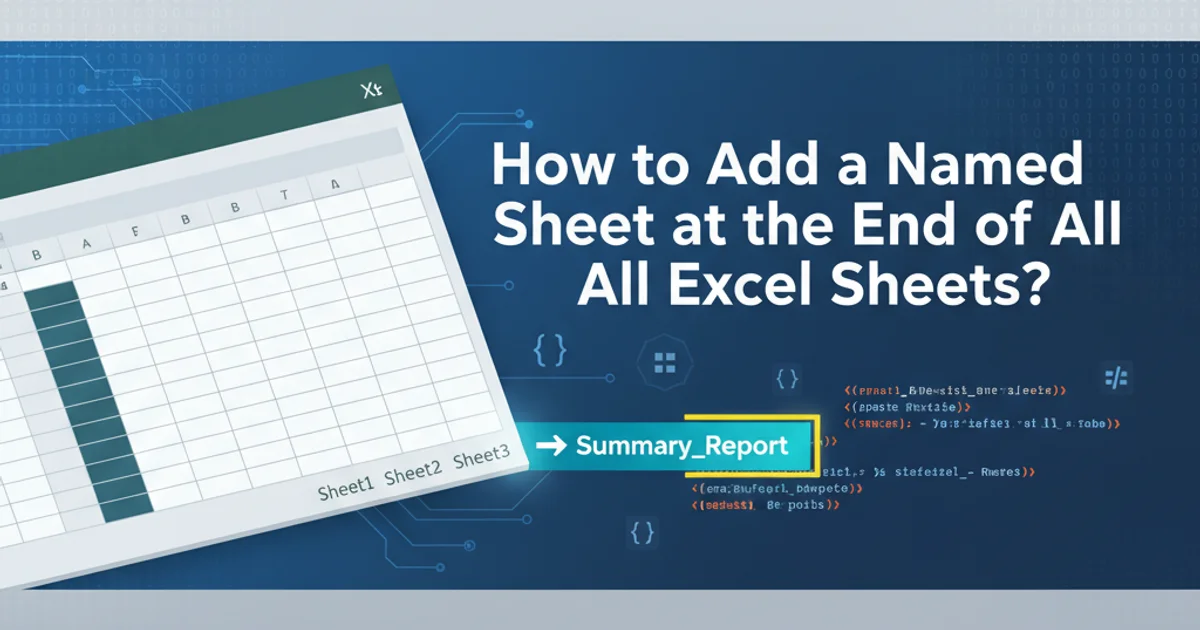How to add a named sheet at the end of all Excel sheets?
Categories:
Adding a New Worksheet at the End of Your Excel Workbook

Learn how to programmatically add a new, named worksheet to the very end of an Excel workbook using VBA, ensuring your data is organized exactly where you need it.
When working with Excel, especially through automation with VBA (Visual Basic for Applications), you often need to add new worksheets. While Excel typically adds new sheets before the active sheet or at a default position, there are scenarios where you specifically need to place a new sheet at the very end of all existing sheets. This article will guide you through the VBA code required to achieve this, ensuring your workbooks remain organized and your automated processes run smoothly.
Understanding Worksheet Objects and the Add Method
In Excel's VBA object model, the Worksheets collection represents all the worksheets in a given workbook. Each individual sheet is a Worksheet object. The Add method of the Worksheets collection is used to create a new worksheet. This method has several optional parameters that allow you to control where the new sheet is placed and what type of sheet it is.
The key parameters for our goal are After and Count. The After parameter specifies an existing sheet after which the new sheet(s) will be added. By setting After to the last existing sheet in the workbook, we can ensure our new sheet appears at the very end. The Count parameter specifies how many sheets to add, which defaults to 1 if omitted.
flowchart TD
A[Start VBA Macro] --> B{Get Active Workbook};
B --> C{Count Existing Worksheets};
C --> D{Identify Last Worksheet: Worksheets(Worksheets.Count)};
D --> E[Add New Worksheet After Last Worksheet];
E --> F[Assign Name to New Worksheet];
F --> G[End Macro];Flowchart illustrating the process of adding a named sheet at the end of an Excel workbook.
Implementing the VBA Solution
To add a new sheet at the end and give it a specific name, we'll use a simple VBA subroutine. The core logic involves determining the total number of sheets to find the last one, and then using the Add method with the After parameter. Finally, we'll assign a name to the newly created sheet.
Sub AddNamedSheetAtEnd()
Dim ws As Worksheet
Dim newSheetName As String
' Define the name for the new sheet
newSheetName = "My New Data Sheet"
' Check if a sheet with the desired name already exists
On Error Resume Next
Set ws = ThisWorkbook.Sheets(newSheetName)
On Error GoTo 0
If Not ws Is Nothing Then
MsgBox "A sheet named '" & newSheetName & "' already exists!", vbExclamation
Exit Sub
End If
' Add a new worksheet after the last existing sheet
' Worksheets.Count gives the total number of sheets, so Worksheets(Worksheets.Count) refers to the last one.
Set ws = ThisWorkbook.Worksheets.Add(After:=ThisWorkbook.Worksheets(ThisWorkbook.Worksheets.Count))
' Name the newly added worksheet
ws.Name = newSheetName
MsgBox "Sheet '" & newSheetName & "' added successfully at the end.", vbInformation
End Sub
VBA code to add a new, named worksheet at the end of the active workbook.
On Error Resume Next block prevents runtime errors if a sheet with the specified name already exists, allowing you to handle the scenario gracefully.How to Use the VBA Code
To implement this solution in your Excel workbook, follow these steps:
1. Open the VBA Editor
Press Alt + F11 to open the Visual Basic for Applications editor.
2. Insert a New Module
In the VBA editor, go to Insert > Module. This will open a new, blank code module.
3. Paste the Code
Copy the provided AddNamedSheetAtEnd subroutine and paste it into the newly created module.
4. Run the Macro
You can run the macro by placing your cursor anywhere inside the Sub routine and pressing F5, or by going to Developer > Macros, selecting AddNamedSheetAtEnd, and clicking Run.
5. Verify the Result
Return to your Excel workbook. You should see a new sheet named "My New Data Sheet" as the very last tab in your workbook.
File > Options > Customize Ribbon and checking the 'Developer' box.